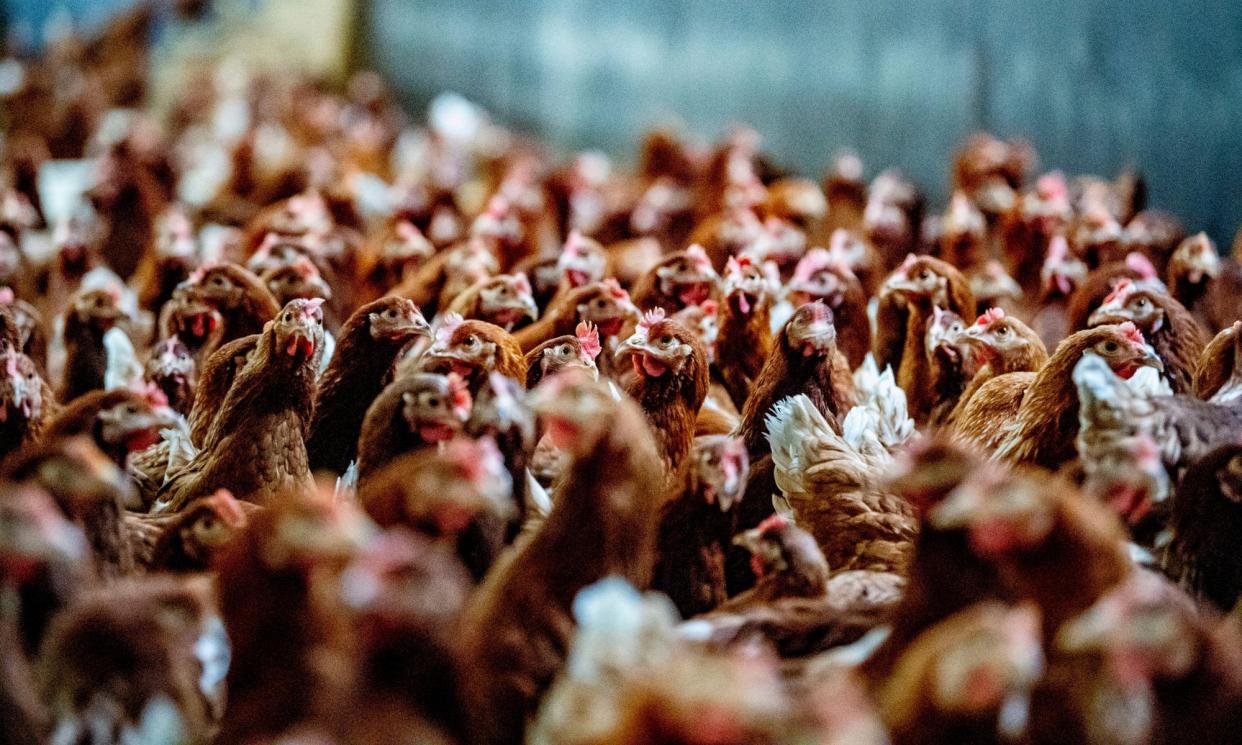Bird flu detected among chickens in Texas and Michigan

Avian influenza has been detected among chickens in Texas and Michigan, following news of the virus infecting livestock and then a person for the first time in the US and potentially leading to supply chain issues.
The developments have led to a heightened focus on the potential risks of the virus, especially in the wake of the devastating coronavirus pandemic. But experts are saying that there is little chance of transmission between humans at this point.
Cal-Maine Foods, the largest producer of fresh eggs in the US, has temporarily halted production at one Texas facility and is killing 1.6 million hens and 337,000 chicks – 3.6% of its entire flock – after discovering the highly pathogenic virus among its domesticated birds.
“These are hard times for dairies and the poultry folks,” said Lewis R “Bud” Dinges, Texas state veterinarian and executive director of the Texas animal health commission.
Outbreaks like these may have repercussions on the price of poultry and eggs, particularly if the virus keeps spreading in domesticated flocks – much like the 2022-23 outbreak that raised the price of eggs by 70%. Continued spread among chickens could also threaten the production of the flu vaccine, which relies on 140m eggs a year to incubate inoculations.
The CDC released a health advisory notice last Friday, recommending that doctors keep a lookout for possible avian flu among patients, especially those who frequently come into close contact with birds and animals.
Anyone in contact with birds and livestock, including agricultural workers, hunters, and backyard farmers, should wear protective gear and follow strict hygiene standards. They “just need to pay extra attention to biosecurity and cleaning and disinfecting”, Dinges said. “Make sure they wash their hands and wear protective clothing and leave their clothing at the facility where they work – clothing and footwear if at all possible.”
An inmate who was culling infected flocks in Colorado became the first person in the US with a known bird flu infection in 2022.
On 20 March, Minnesota reported that baby goats were sickened by bird flu, marking the first time the virus had been discovered in livestock. Days later, the virus was also discovered among cows. Cows in North Carolina tested positive for bird flu on Wednesday, bringing the affected count up to 21 herds in seven states.
Genomic sequencing revealed that the spillover to cows did not seem to make the virus more transmissible to humans this time, so the risk of sustained human-to-human transmission is still low, said Seema Lakdawala, associate professor of microbiology and immunology at Emory University School of Medicine.
“Transmission of influenza viruses in humans requires lots of different variables to align just right, and the current H5N1 viruses do not have all the correct parameters for spreading between humans,” she wrote in an email.
“However, the more the virus spills from birds into other hosts like cattle, foxes, seals, etc the more likely the virus is to change and gain properties that could lead to successful human-to-human transmission.”
Avian influenza is “an emerging disease” among livestock, Dinges said, “and there’s a lot that we don’t know about the pathogenesis in the cow itself. We’re still kind of learning as we go here.”
It’s not clear how the herds encountered the virus, but the genomic sequences are very similar – pointing to a single introduction, probably from a dead bird, that spread within the herds rather than several introductions over time.
The outbreak among dairy cows could lead to local shortages, but for now it’s unlikely to create national or regional shortages or price increases, said Tinglong Dai, professor of business at the Johns Hopkins University Carey Business School. That’s because the US is in its high season for milk production.
“In the spring and summer, usually, you have higher yields than during the winter,” he said. “Suppose this happened in the fall or in the winter: the supply chain impact would have been much bigger.”
If the outbreak among cows continues in the fall, it could affect supply and prices. In the meantime, affected cows are being isolated until their illnesses pass.
Chickens, on the other hand, usually die from the virus, so producers cull them as soon as the virus is detected.
“The most effective way to stop the spread is to kill the chickens,” Dai said. That means prices for poultry and eggs could be more affected by this outbreak than for milk and cheese.
The manufacturing process for flu shots also relies heavily on eggs, and egg shortages in the past have led to vaccine shortages. So far, no vaccine makers have reported shortages.
“It’s just if the situation keeps going – if infection spreads, again, we need to monitor very, very closely,” Dai said. “This also depends on how this is going to evolve in the coming days.”
Scientists are sounding the alarm in order to keep farmers and other agricultural workers safe, and to continue monitoring the spread of the virus.
For example, it’s not clear how common it is for avian influenza to spill over from birds to animals, Lakdawala said. “Currently, in the US, most of this surveillance is from examination of animals that are found sick or died.”
If the virus has been quietly spilling over into other animal hosts that don’t get very sick or die – as with white-tailed deer and Covid – scientists don’t know about it. That’s why they need more funding for monitoring concerning viruses like the flu, Lakdawala said.
“This is a gap we need to try to fill, but is hard to do without more resources and investment into large-scale surveillance programs.”


